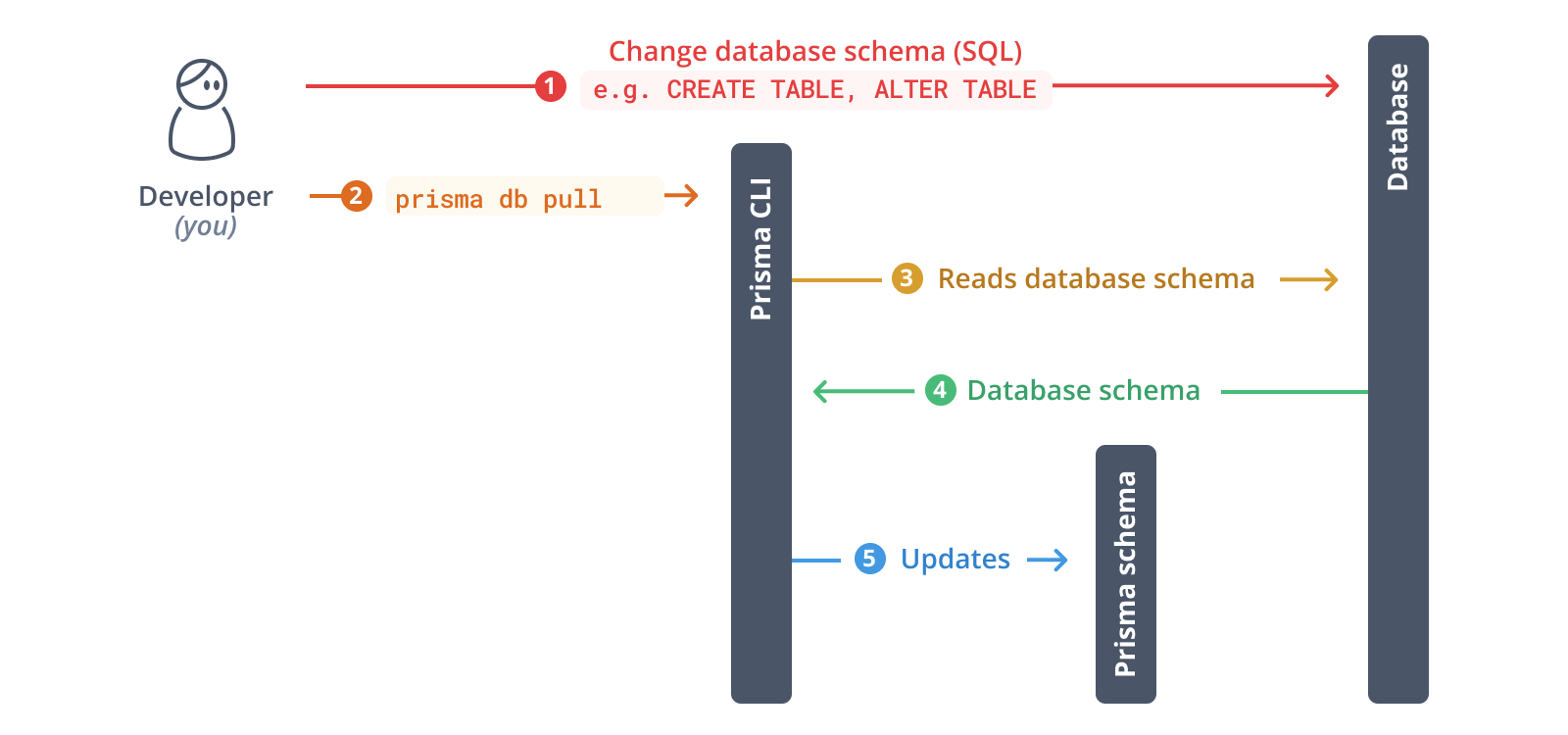JavaScript 项目中 MySQL 的内省
使用 Prisma ORM 内省您的数据库
为了本指南的目的,我们将使用一个包含三个表的演示 SQL 模式
CREATE TABLE User (
id INTEGER PRIMARY KEY AUTO_INCREMENT NOT NULL,
name VARCHAR(255),
email VARCHAR(255) UNIQUE NOT NULL
);
CREATE TABLE Post (
id INTEGER PRIMARY KEY AUTO_INCREMENT NOT NULL,
title VARCHAR(255) NOT NULL,
createdAt TIMESTAMP NOT NULL DEFAULT now(),
content TEXT,
published BOOLEAN NOT NULL DEFAULT false,
authorId INTEGER NOT NULL,
FOREIGN KEY (authorId) REFERENCES User(id)
);
CREATE TABLE Profile (
id INTEGER PRIMARY KEY AUTO_INCREMENT NOT NULL,
bio TEXT,
userId INTEGER UNIQUE NOT NULL,
FOREIGN KEY (userId) REFERENCES User(id)
);
展开查看表的图形概览
用户
| 列名 | 类型 | 主键 | 外键 | 必需 | 默认 |
|---|---|---|---|---|---|
id | INTEGER | ✔️ | 否 | ✔️ | 自增 |
name | VARCHAR(255) | 否 | 否 | 否 | - |
email | VARCHAR(255) | 否 | 否 | ✔️ | - |
帖子
| 列名 | 类型 | 主键 | 外键 | 必需 | 默认 |
|---|---|---|---|---|---|
id | INTEGER | ✔️ | 否 | ✔️ | 自增 |
createdAt | DATETIME(3) | 否 | 否 | ✔️ | now() |
title | VARCHAR(255) | 否 | 否 | ✔️ | - |
content | TEXT | 否 | 否 | 否 | - |
published | BOOLEAN | 否 | 否 | ✔️ | false |
authorId | INTEGER | 否 | ✔️ | ✔️ | false |
档案
| 列名 | 类型 | 主键 | 外键 | 必需 | 默认 |
|---|---|---|---|---|---|
id | INTEGER | ✔️ | 否 | ✔️ | 自增 |
bio | TEXT | 否 | 否 | 否 | - |
userId | INTEGER | 否 | ✔️ | ✔️ | - |
下一步,您将内省您的数据库。内省的结果将是您 Prisma 模式中的一个数据模型。
运行以下命令来内省您的数据库
npx prisma db pull
此命令读取在 .env 中定义的 DATABASE_URL 环境变量并连接到您的数据库。连接建立后,它将内省数据库(即,它会读取数据库模式)。然后,它将数据库模式从 SQL 转换为 Prisma 数据模型。
内省完成后,您的 Prisma 模式会更新

数据模型现在看起来类似于这样(请注意,模型的字段已重新排序以提高可读性)
model Post {
id Int @id @default(autoincrement())
title String @db.VarChar(255)
createdAt DateTime @default(now()) @db.Timestamp(0)
content String? @db.Text
published Boolean @default(false)
authorId Int
User User @relation(fields: [authorId], references: [id], onDelete: NoAction, onUpdate: NoAction, map: "Post_ibfk_1")
@@index([authorId], map: "authorId")
}
model Profile {
id Int @id @default(autoincrement())
bio String? @db.Text
userId Int @unique(map: "userId")
User User @relation(fields: [userId], references: [id], onDelete: NoAction, onUpdate: NoAction, map: "Profile_ibfk_1")
}
model User {
id Int @id @default(autoincrement())
name String? @db.VarChar(255)
email String @unique(map: "email") @db.VarChar(255)
Post Post[]
Profile Profile?
}
有关模式定义的详细信息,请参阅Prisma 模式参考。
Prisma ORM 的数据模型是您的数据库模式的声明性表示,并作为生成的 Prisma Client 库的基础。您的 Prisma Client 实例将公开为这些模型量身定制的查询。
目前,数据模型存在一些小“问题”
User关系字段采用大写形式,因此不符合 Prisma 的命名约定。为了表达更多的“语义”,如果此字段名为author以更好地描述User和Post之间的关系,那也将很好。User上的Post和Profile关系字段以及Profile上的User关系字段都采用大写形式。为了遵守 Prisma 的命名约定,这两个字段都应该小写为post、profile和user。- 即使小写后,
User上的post字段仍然有点命名不当。那是因为它实际上指的是一个帖子列表——因此,更好的名称应该是复数形式:posts。
这些更改对于生成的 Prisma Client API 很重要,因为使用小写的 author、posts、profile 和 user 关系字段对于 JavaScript/TypeScript 开发者来说会更自然和符合习惯。因此,您可以配置您的 Prisma Client API。
因为关系字段是虚拟的(即它们不会直接在数据库中体现),您可以在 Prisma 模式中手动重命名它们而无需触及数据库
model Post {
id Int @id @default(autoincrement())
title String @db.VarChar(255)
createdAt DateTime @default(now()) @db.Timestamp(0)
content String? @db.Text
published Boolean @default(false)
authorId Int
author User @relation(fields: [authorId], references: [id], onDelete: NoAction, onUpdate: NoAction, map: "Post_ibfk_1")
@@index([authorId], map: "authorId")
}
model Profile {
id Int @id @default(autoincrement())
bio String? @db.Text
userId Int @unique(map: "userId")
user User @relation(fields: [userId], references: [id], onDelete: NoAction, onUpdate: NoAction, map: "Profile_ibfk_1")
}
model User {
id Int @id @default(autoincrement())
name String? @db.VarChar(255)
email String @unique(map: "email") @db.VarChar(255)
posts Post[]
profile Profile?
}
在此示例中,数据库模式确实遵循了 Prisma ORM 模型的命名约定(只有从内省生成的虚拟关系字段不符合约定,需要调整)。这优化了生成的 Prisma Client API 的人体工程学。
不过,有时您可能希望对 Prisma Client API 中公开的列和表的名称进行额外更改。一个常见的例子是将数据库模式中常用的snake_case(蛇形命名法)转换为对于 JavaScript/TypeScript 开发者而言更自然的PascalCase(帕斯卡命名法)和camelCase(驼峰命名法)。
假设您从基于snake_case(蛇形命名法)的内省中获得了以下模型
model my_user {
user_id Int @id @default(autoincrement())
first_name String?
last_name String @unique
}
如果您为此模型生成 Prisma Client API,它将在其 API 中采用snake_case(蛇形命名法)
const user = await prisma.my_user.create({
data: {
first_name: 'Alice',
last_name: 'Smith',
},
})
如果您不想在 Prisma Client API 中使用数据库中的表名和列名,您可以使用@map 和 @@map 来配置它们。
model MyUser {
userId Int @id @default(autoincrement()) @map("user_id")
firstName String? @map("first_name")
lastName String @unique @map("last_name")
@@map("my_user")
}
通过这种方法,您可以随意命名您的模型及其字段,并使用 @map(用于字段名)和 @@map(用于模型名)指向底层表和列。您的 Prisma Client API 现在看起来如下所示
const user = await prisma.myUser.create({
data: {
firstName: 'Alice',
lastName: 'Smith',
},
})
有关此内容的更多信息,请访问配置您的 Prisma Client API 页面。